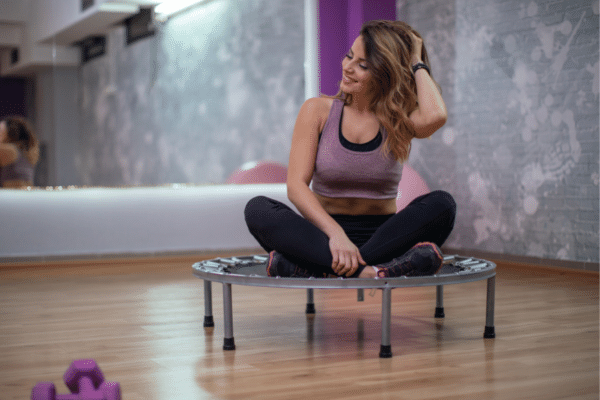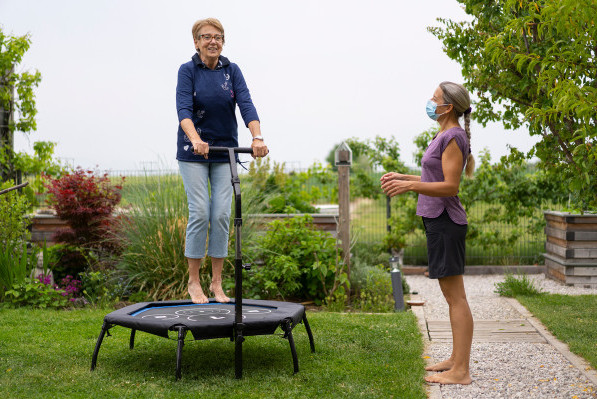Trampoline history facts and benefits. George Nissen, patented the “tumbling devise” on March 6, 1945. George was still doing handstands at 80 and yoga headstands in his 90s. He died at 96.
If we can use George Nissen as a good example, then trampolines are highly effective and get results.
George maintained flexibility, strength, good posture, and balance, right into old age.
This post contains affiliate links. If you click on and purchase through one of those links, you won’t pay a penny more, but we’ll get a small commission, which helps keep our website operating. Thanks! As an Amazon Associate, I earn from qualifying purchases.
Who Invented the Trampoline – a Bit of History Facts
Nissen, an Iowa native, trained at tumbling during junior high and high school. He went to circus performances with his family. The trapeze artists left him speechless. They would fly through the air and drop into safety netting at the end of their act. They would rebound into somersaults or other stylish moves.
Scrap Steel and Canvas
After completing high school at 16, Nissen set out to build a bouncing apparatus in his parents’ garage. He used scrap steel and built a rectangular frame, with a piece of canvas stretched across the top
During college George and his friends introduced the first successful rig at a summer camp where they held jobs as counselors. It became an instant success.
His 1937 bachelor’s degree in business put him in good stead as he further developed his business enterprise.
Check out David Hall’s Cellercise®.

Traveling Acrobats and the Trampoline Was Born
Soon after, Nissen and his two friends traveled, doing acrobatics in Texas and Mexico. After learning the Spanish name for a diving board is el trampolin: he registered his bouncing rig with the trademark of a “Trampoline”.
His trampolines became a popular attraction at school assemblies and thus his business began to bud.
Trampoline History Facts and Benefits
Nissen improved the design. When World War II began, he began pitching his trampolines as a training tool for military parachutists, pilots, and divers to help them orient themselves in space.
After the War the American and Soviet astronauts used the trampoline in their training. It helped them experience different body positions during weightlessness while in space.
In 1956 he took his trampoline business to England, and before long there were more than 50 manufacturers of similar devices worldwide.
Check out the Maximus HIIT Bounce Pro USA here.

NASA and the Trampoline
In 1980, NASA conducted the most important and frequently quoted scientific research study on trampolining. Research was done by the Biomechanical Research Division, NASA-Ames Research Center, Moffett Field, California, in cooperation with the Wenner-Gren Research laboratory, University of Kentucky, Lexington, Kentucky.
The History and Benefits of Trampolines
- Helped astronauts regain bone and muscle mass after returning from space.
- Heart rate and oxygen levels much higher than that achieved with running.
The NASA study used a competition-style trampoline – 9’ x 15’ – not a mini trampoline.
Who Invented the First “Small Trampoline”?
The “small trampoline” was first created by Ed Russell. He left his ideas and prototype to Victor Green who patented the small trampoline in 1975. American companies quickly began manufacturing these mini trampolines.
Al Carter trained his own children to use the trampoline. He saw their increased endurance, coordination, and mental development. Their good health and superior strength inspired him to research and write the book, Rebound to Better Health, 1977. Al Carter developed the first home-sized mini trampoline.
The New Miracles of Rebound Exercise is another book by Al Carter, the inventor of the ReboundAir Mini Trampoline
What Do Trampolines Do for Your Body?
Rebounding provides the benefit of great aerobic exercise. As you bounce up and down, the force of gravity strengthens all the cells of your body. With increased circulation, more oxygen reaches every cell throughout the body.
The Trampoline Improves:
- Posture
- Heart Rate
- Bone Density
- Core Strength
- Balance and Coordination
- Muscle and Joint Strength
- Metabolism – Reduces Body Fat
- Cardiovascular and Respiratory Fitness
- Lymph Circulation and a Boosted Immune System
Pros and Cons of Trampoline Exercise
Trampoline Parks
There were many trampoline parks in the late 1950s and early 1960s. The safety standards were not high. As a result, injuries were high. New safety measures were in place in 2002, in this newly designed facility, safety measures created a safe place for kids to have fun.
Backyard Trampolines
Large backyard trampolines are dangerous as well as the trampoline parks. Some kids may break their bones. It is especially dangerous if many children are jumping at the same time. Safety nets surrounding backyard trampolines help eliminate some injuries.
Mini Trampolines
The mini trampoline is a small version of the large backyard trampoline. It is three to four feet in diameter. People do not do back flips and other type of gymnastics on mini trampolines. This makes them much safer and avoids many injuries.
Some mini trampolines have handlebars for added stability while you are jumping.
Most people would agree that using a trampoline makes you stronger and healthier. And, you can use a mini trampoline inside – rain or shine – in any type of weather.
Trampoline Benefits for Weight Loss
Jumping on a trampoline for weight loss may seem too good to be true. However, if combined with a proper diet, and done consistently, you can lose weight. The amount of weight lost will vary with each individual.
Jumping on a trampoline exercises the whole body. The bouncing helps to firm up every part of your body, including legs, thighs, arms, hips, and stomach.
Benefits of Rebounding for Seniors
Rebounding is a form of low-impact aerobic exercise. It is a relatively easy way to increase your heart rate without straining your joints and muscles. The springs or bungee cords absorb much of the shock that you would get when walking or running. Some people prefer mini trampolines with bungee cords rather than those with springs for the greater shock absorption.
An increase in oxygen helps you think clearer, lowers stress, and promotes those feel-good endorphins.
Improves Confidence
The benefits for seniors can be huge. Mini trampolines improve confidence as seniors improve their balance and flexibility. This in turn reduces the risks of falls.
We recommend the use of handlebars to give you added security while bouncing.
If you have back injuries, heart problems or other health concerns, consult with your physician before beginning a new exercise routine.
Benefits of Trampoline for Autism
The use of a trampoline can be beneficial to autistic persons with limited communication skills. When they cannot express their stress and anxiety, jumping on a trampoline can help control the stress and anxiety in a person with special needs.
According to the American Academy of Pediatrics, young children lack the coordination and ability to use a trampoline. Falls leading to broken bones are all too familiar. Children under the age of six should not use trampolines.
Check out the three models of ReboundAir Mini Trampoline below.
Standard Rebounder by ReboundAir

Classic Rebounder by ReboundAir

Ultimate Rebounder by ReboundAir

In Conclusion
When used consistently, the trampoline can improve your health and activity. Gymnasts and the military, alike used trampolines. These trampoline history facts and benefits show what the trampoline can do in war time and in peace. The professional or the casual individual who wants to improve their physical health will find the trampoline very useful.
Please Leave a Comment
I would love to hear from you. Have you used a trampoline? Which one would you choose?
Disclaimer: If you have any concerns or questions about your health, you should always consult with a physician or other healthcare professional. No content on this site should be substituted for direct medical advice from your doctor or other qualified healthcare practitioner. The information contained here is for informational purposes only. It is from my research and personal experience.
Related Posts
The 7 Best Rebounders with Bungee Cords for an Unbelievable Workout
Rebounding and Cellulite – Fact and Fiction
The Benefits of the Mini Trampoline and How NASA Uses the Trampoline
The Best Rebounder Mini Trampoline with Handlebars



I relly didn’t know all these facts about the trampoline and for what purposed they used it. My children love the trampoline and what I know about it is that it allows children to have good coordination and good mental health. Any psyhical activity, including trampoline exercises, is good for proper growth and development in children
Hi Bojana, thanks for stopping by with a comment. Trampolines are a great way for kids to get exercise and have fun, however, I know at least 2 young ones who were injured while using them. I personally like the trampolines with covered springs to protect anyone getting caught in the springs.
Now there are smaller, safer mini trampolines you can have inside. When the weather is not pleasant, you are still able to get exercise inside. I have, and use a mini trampoline at home.
Thank you for such an informative post. I never knew that trampolines had so much history. After reading your article I am sure that trampolines help a lot in our body fitness and exercising using them is also pretty fun. Although my son was asking for one, now I am also thinking of buying one from your recommended list of trampolines. According to you which one is the best for kids as well as for adults?
Hi Hari, thanks for stopping by with a comment! It is interesting to find out the origin of the trampoline. Young inventors filled their needs and the needs of others as well.
As to what kind of trampoline is best for kids and adults. It depends on a number of things. Do you want the kids to play out in the yard. They should do it with supervision, and covered springs and a safety net make it safer.
The highest quality and most expensive mini trampoline is the Bellicon. It has the deepest bounce, and the bounce has a “feel” of quality. The Stamina is a good quality entry-level mini trampoline. They say the better quality ones have a better “feel” as you jump. Needak has a good quality soft bounce, however the springs are noisier than a bungee cord trampoline. JumpSport is used professionally in classes and is a good choice at home.
I suppose your budget will help you decide which one to choose.
Happy bouncing!
Hey thanks for this post!
It was definitely an interesting read. I love trampolining, saying that however I haven’t been on one for quite a while, probably 6 years now. I wasn’t aware trampolining had quite a bunch of benefits, definitely worth looking at!
And wow George really surprised me, flexible at that age when nowadays youngsters are not that flexible and active! And that sure is a ripe old age.
Hi Sariyah, Yes George is certainly an inspiration. When we do the little that we can do, we can surprise our self, with what we can accomplish!